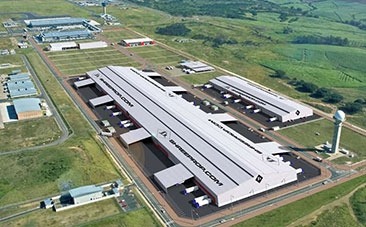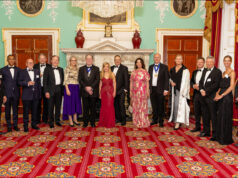The official launch of the Dube TradePort Industrial Development Zone (DTP IDZ) reaffirms its role as an important investment destination not only for KwaZulu-Natal but for South Africa as a whole.
Located 30 kilometres north of Durban, the DTP IDZ is a business entity of the KwaZulu-Natal provincial government aimed at attracting investment in the province. Considered one of South Africa’s top 10 investment opportunities, the DTP IDZ prides itself as the only facility in Africa combining an international airport, dedicated cargo terminal, warehousing, offices, retail, hotels and agriculture.
Speaking at the official launch of the IDZ attended by top national and provincial government leaders on Tuesday, 7 October, chairperson of the DTP IDZ board Dr Zanele Bridgette Gasa said the IDZ has attracted plenty of private sector interest since it was designated an industrial development zone in July this year.
Local and international investment
“Against the backdrop of exceptionally pleasing private sector interest in and uptake of investment opportunities at Dube TradePort, we are excited by the designation of Dube TradePort as an Industrial Development Zone which will allow us to further target local and foreign investment. Work on this front is ongoing and we anticipate forging synergistic relationships with other identified industrial economic hubs for the benefit of the entire Province and its business community,” she said.
Adding, Gasa said the DTP IDZ is Africa’s first purpose-built aerotropolis with an international airport as its core.
“This freight-orientated Aerotropolis coupled with IDZ designation will certainly quicken the pace of development at Dube TradePort and, I would confidently add, increase demand for greater levels of airlift out of Durban to domestic, regional and international markets. This would, in turn, augment efforts to grow our strategically influential location – together with two of Africa’s major seaports – to become a truly viable and sustainable alternative gateway to South Africa, Africa and the world.”
Over the past five years, the DTP IDZ has grown in size to 2 840 hectares and has managed to attract over R 900 million in private investment. During this time it has managed to create an estimated 16 527 new job opportunities across the country and it is envisaged this number will increase with new development opportunities.
Benefits for enterprises
The DTP IDZ carries with it a range of benefits for enterprises, according to Saxen van Coller, DTP IDZ’s chief executive officer. These benefits include both fiscal and customs incentives which are specifically geared towards agri-processing and manufacturing enterprises located within Dube TradeZone and Dube AgriZone.
“This represents the first phase of Dube TradePort Corporation’s roll-out and will cover some 300 hectares of agri- processing and industrial activities, growing to more than 700 hectares into the future,” said Van Coller.
The Dube TradePort Industrial Development Zone will have a set of priority sectors that will comprise the core of its clustering approach, through which it will drive growth.
These sectors include:
- Aerospace and aviation-linked manufacturing and related services
- Agriculture and agro-processing, inclusive of horticulture, aquaculture and floriculture
- Electronics manufacturing and assembly
- Medical and pharmaceutical production and distribution
- Clothing and textiles
However, supplementary sectors will form part of the IDZ’s approach and include freight-forwarding and aviation services; warehousing and storage; logistics and distribution, light manufacturing and assembly; high-tech and automotive industries; and aquaculture and cold storage, among other supplementary sectors.
Support from national government
The IDZ enjoys support from national government by forming part of South Africa’s National Infrastructure Plan, as outlined in the Presidential Infrastructure Co-ordinating Commission (PICC) under Strategic Infrastructure Programme 2, according to Michael Mabuyakhulu, MEC for economic development, tourism and environmental affairs in KwaZulu-Natal. “Government’s backing and our bold vision of a 60-year master plan, gives investors the security of sustained growth and development,” he said.
Officially launching the DTP IDZ, President Jacob Zuma said the DTP IDZ takes forward South Africa’s industrialisation and development goals. He said the IDZ has enormous potential for economic growth in KwaZulu-Natal. “With everything going well as planned, it is expected that the contribution of the Dube Trade Port to the Gross Domestic Product would amount to R5.6 billion by 2060,” he said.
Since the announcement of the new support package for IDZs, there has been a significant interest by foreign and domestic investors, according to Zuma.
“This year alone the COEGA Industrial Development Zone in Port Elizabeth has attracted over R1.8 billion in investments.
“The East London Industrial Development Zone has attracted over R500 million in investments. The Saldanha Industrial Development Zone, though new and not fully developed, has already attracted interest of 19 potential investors who would like to be located there,” Zuma said.
South Africa’s IDZs have made crucial contributions to the economic success of many developing nations including China which has emerge as a global economic powerhouse. South African policy makers have worked tirelessly to successfully test the market economy business and have created these Industrial Development Zone designations in line with the country’s industrial development strategy, according to a statement from the DTP IDZ.
“The aim [is] to bring in new institutions that will contribute significantly to gross domestic product, employment, exports, and attraction of foreign investment, as well as the adoption of new technologies and management practices helping to create a model for the rest of the country to follow,” affirms the statement.
Read more: http://www.southafrica.info/news/1646684.htm#.VEEdzfnF-yW#ixzz3GPUAKD1H
This article was originally published by Brand South Africa on 9 October 2014.










